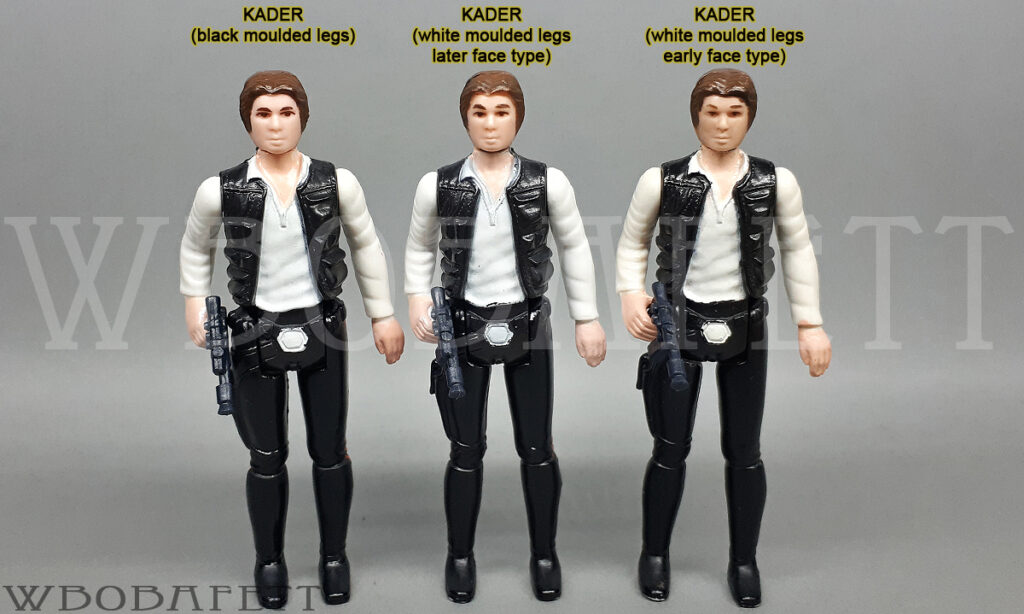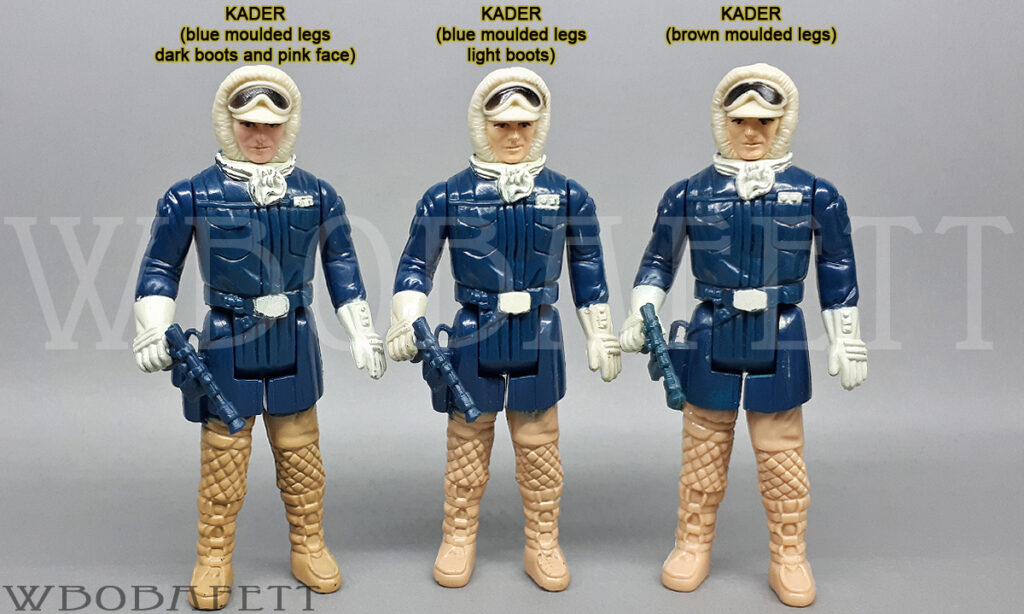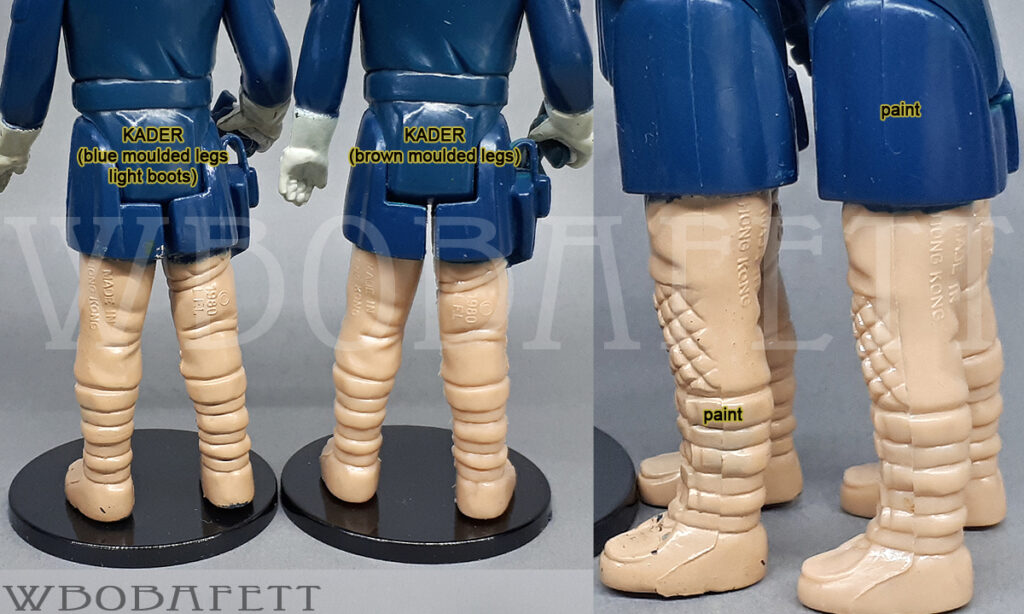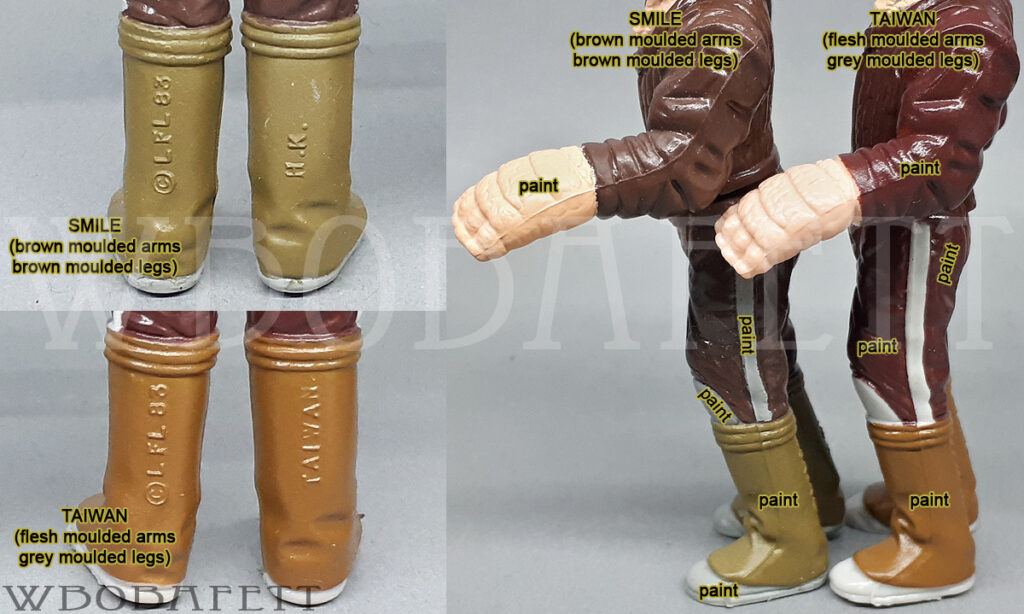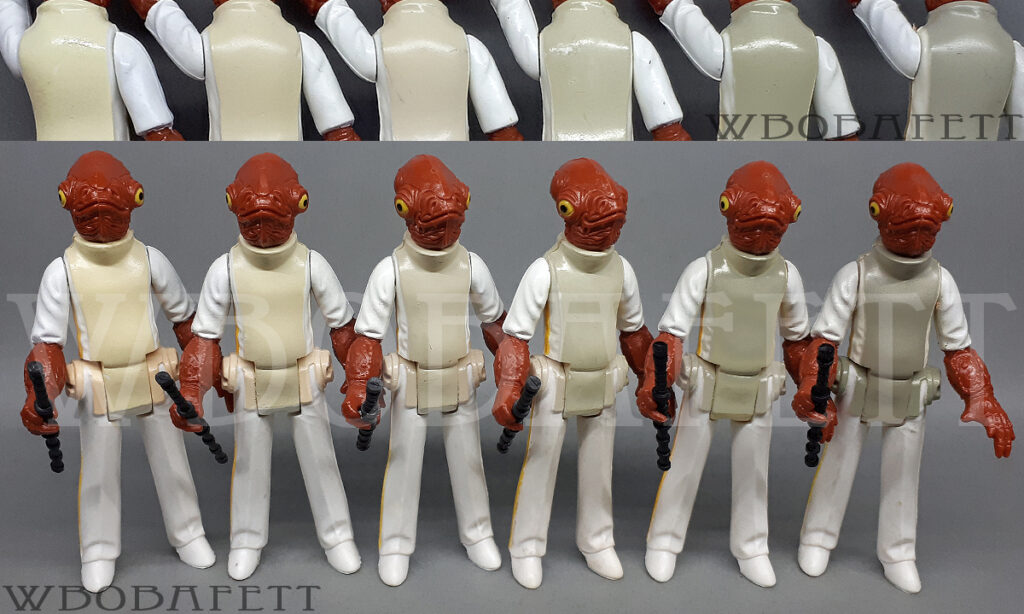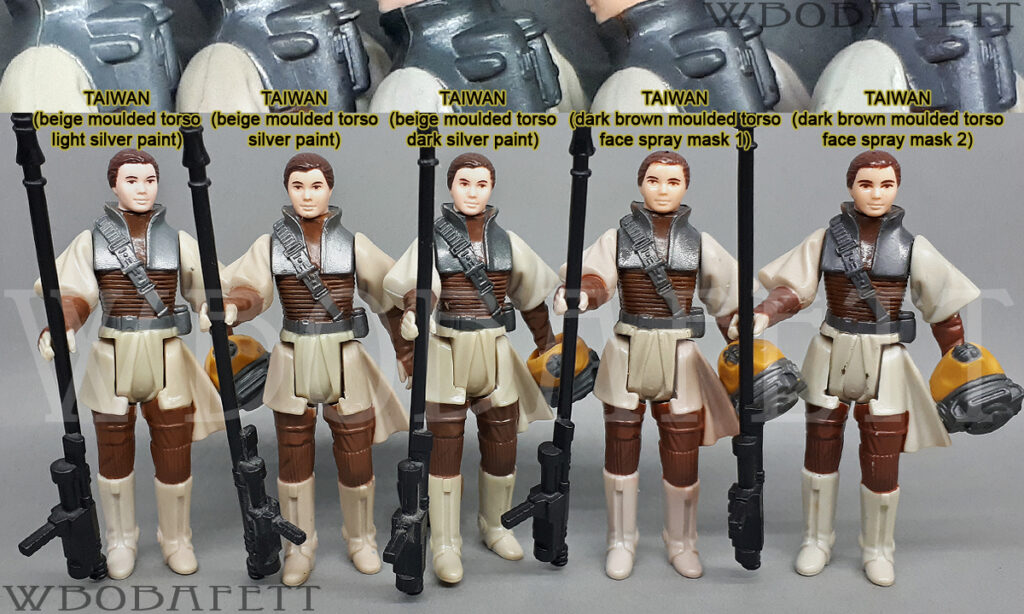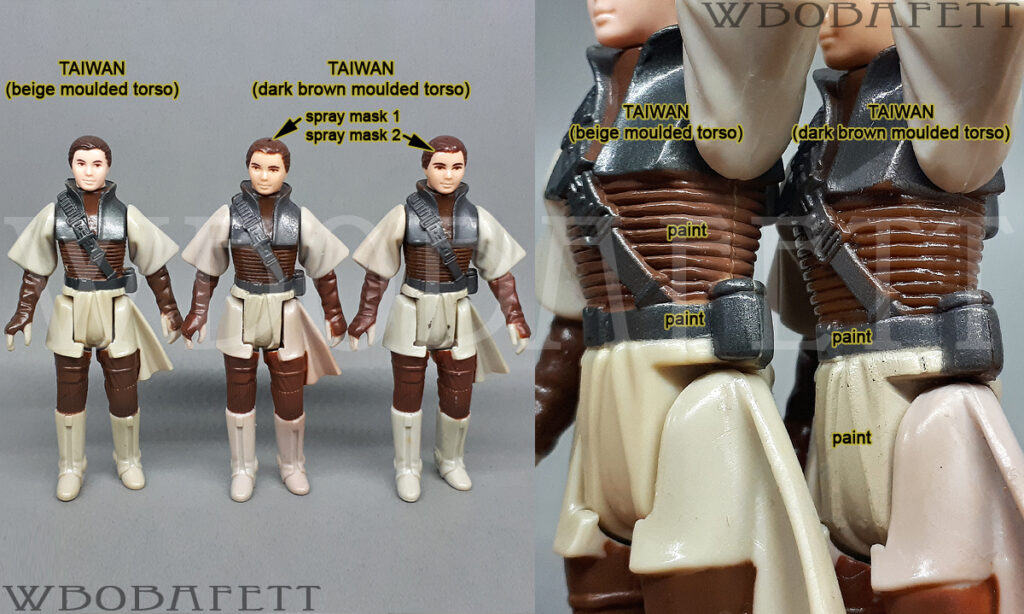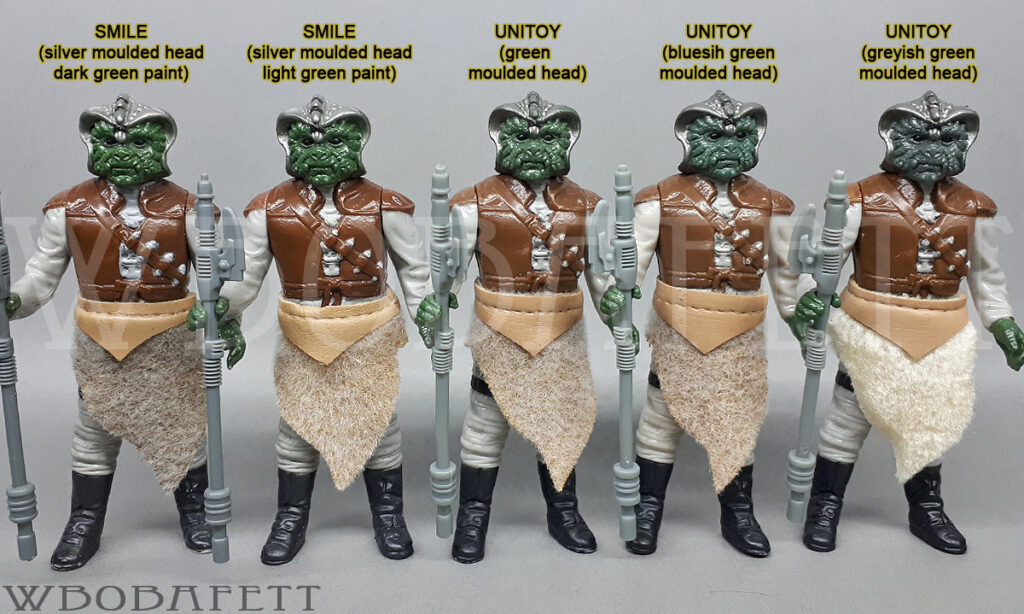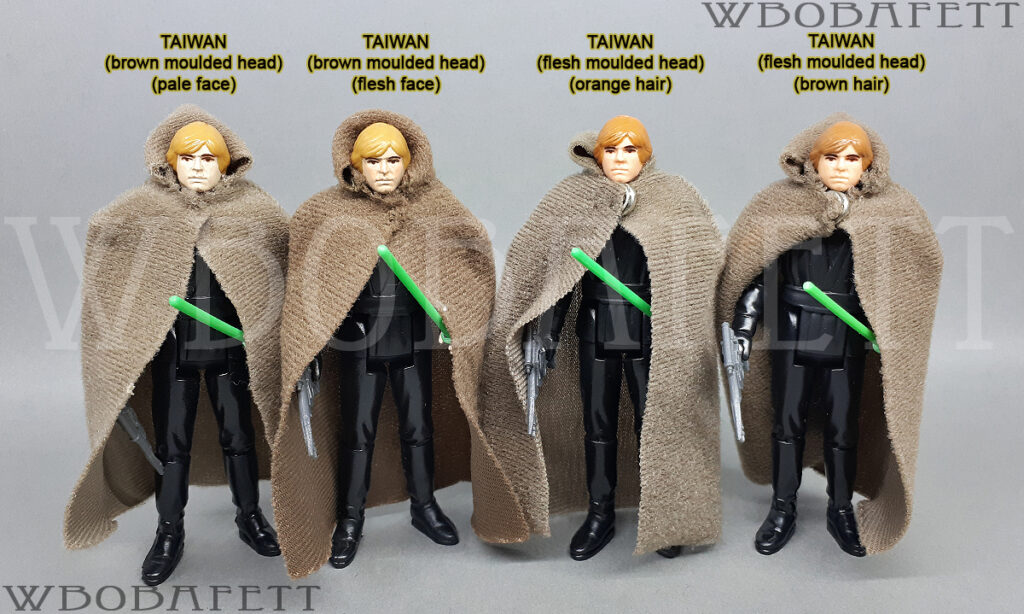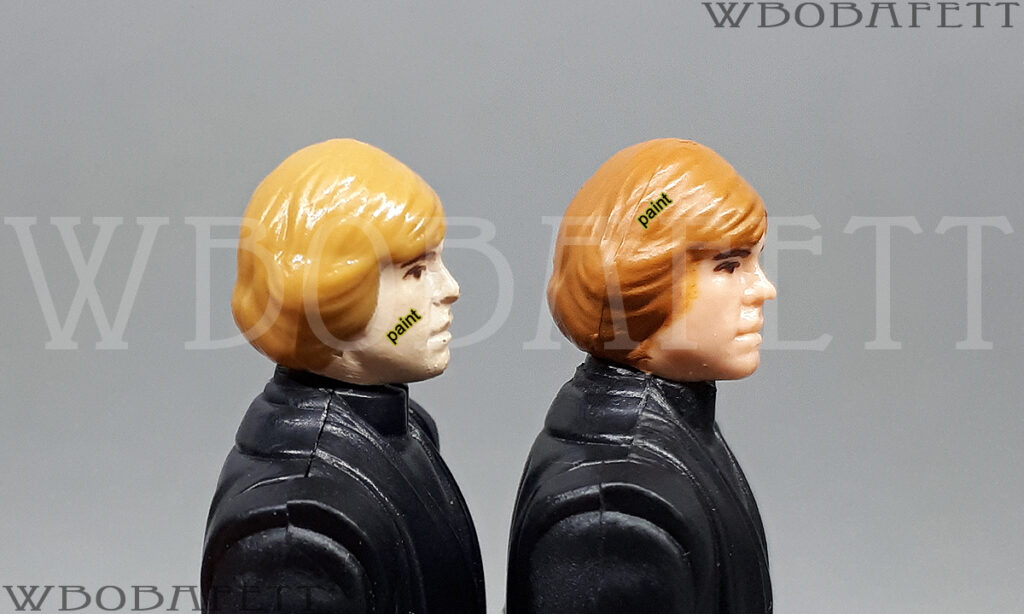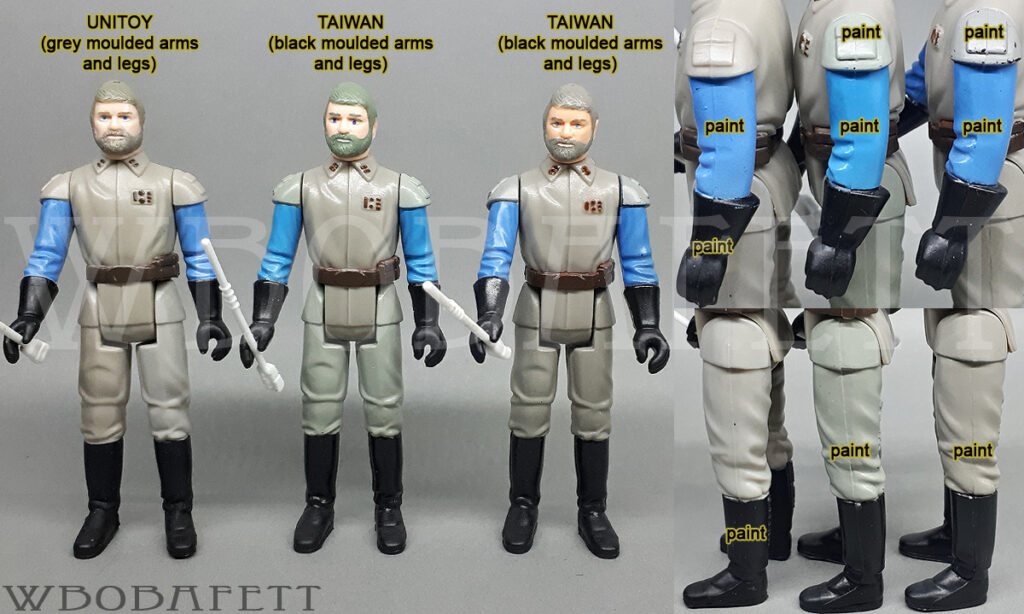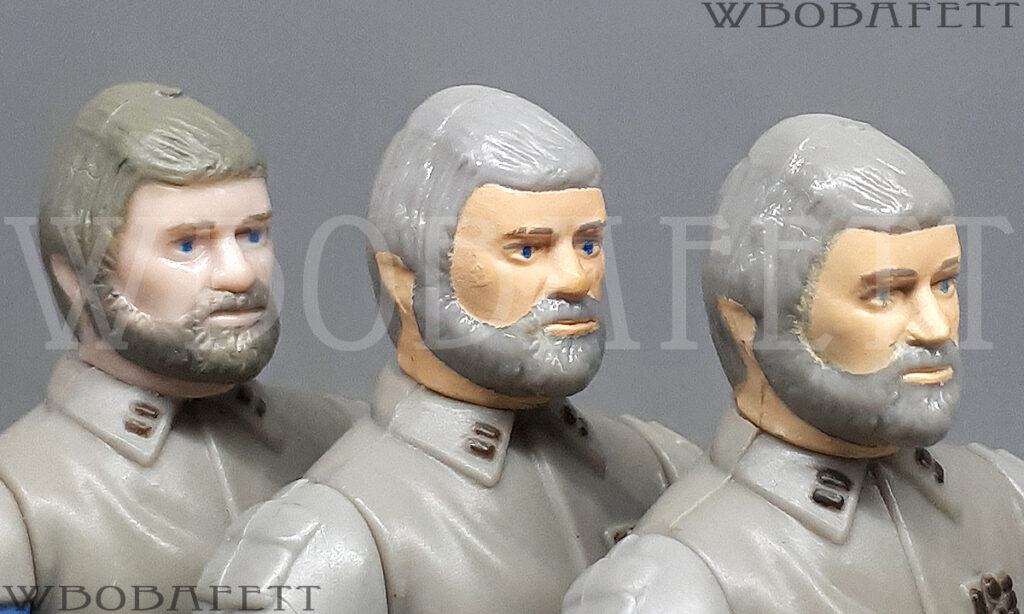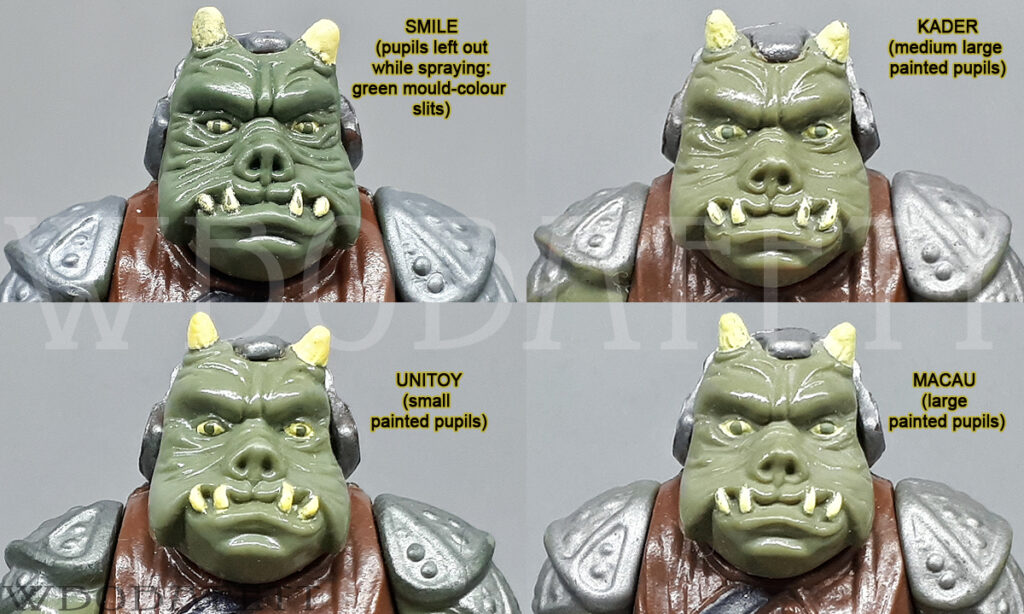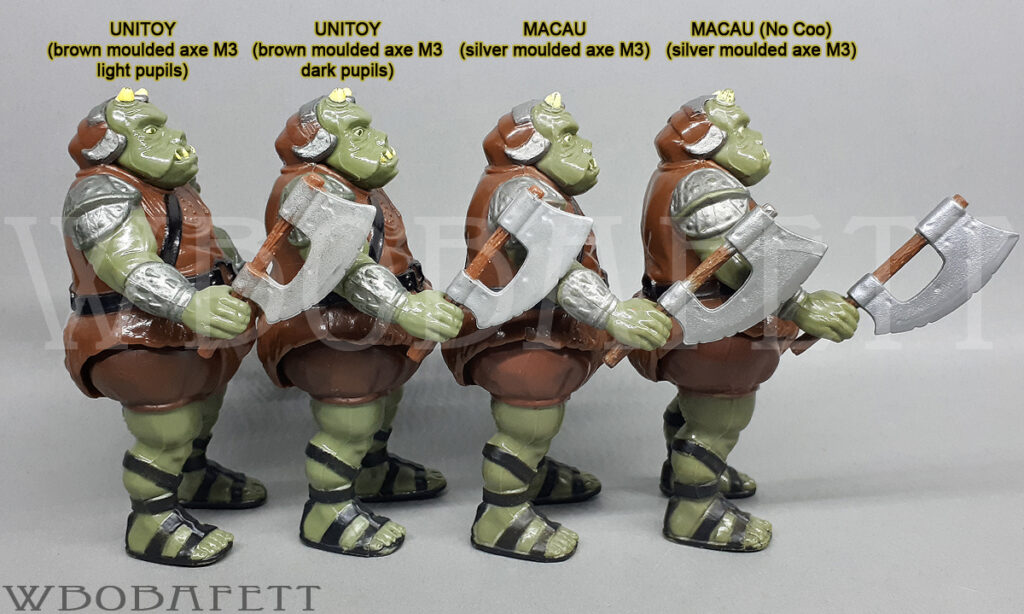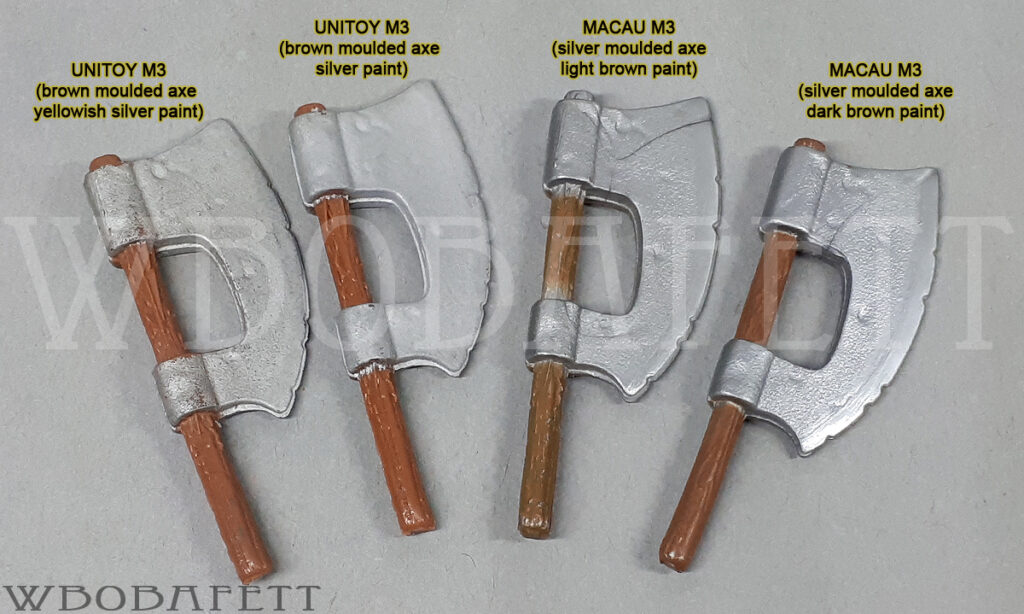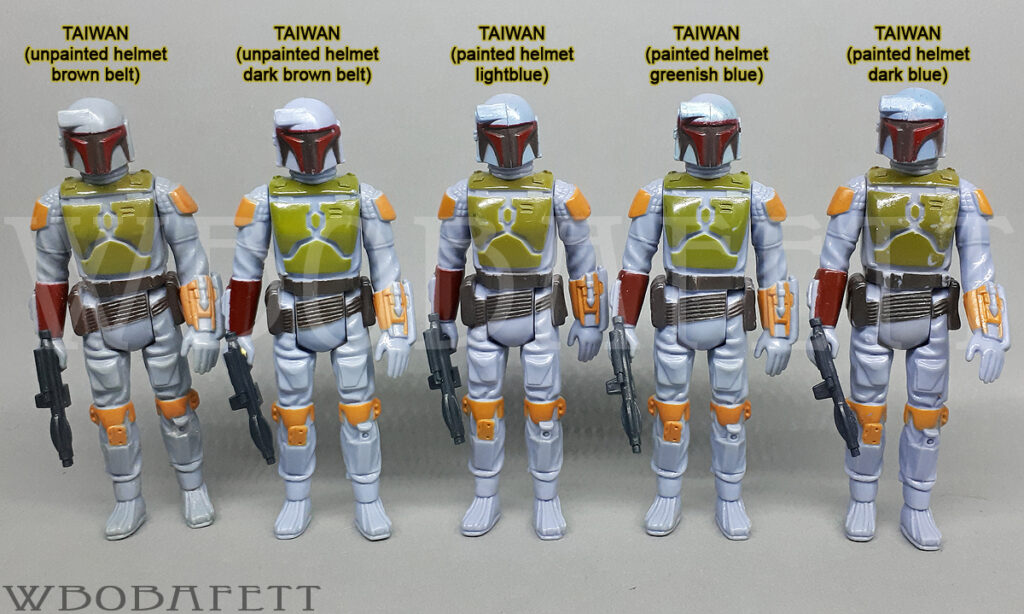FIGURE VARIATIONS
Mould-Colour Variants
The Han Solo figure with small head produced by KADER is the earliest known mould-colour variant. In the middle and to the right you can see two figures with white moulded legs. These are then totally sprayed over with black colour. On the left you can see the later version with legs already moulded in black.
Please also note that the later version and the version in the middle share the same spray mask and details for the face. The figure to the far right has different details regarding the face and can be considered the very earliest release.
It never made sense to me that a factory like KADER decides to do something that illogical. It is more complex and it is more expensive. Years later I noticed that all figures in the ANH line have something in common: On all characters the legs and arms are moulded in the same colour, i.e. Greedo has green arms and legs, Luke Farmboy has white moulded arms and legs and so on. It could be possible that at least the first 12 figure were produced in a similar way like i.e. Uzay or Polish bootleg figures, with arms and limbs together on one sprue tree and therefore shot in the same plastic colour. That would explain why the early Hans are produced with white moulded arms and legs even if the factory then had to completely overspray the whole legs. In my opinion this is the only logical explanation. The production then was changed very fast and Han was build from black moulded legs and white moulded arms.
If you want to spot a “white moulded legs” Han Solo take a look at the peg holes and look for tiny rubs to the feet or to the hip.
While Han Solo with “white moulded legs” is a real oddity, the next produced Han Solo in Hoth Outfit by KADER shows the true reasons for mould-colour variants among the Star Wars vintage Kenner figures. To the right you can see Han with brown moulded legs and blue paint applied to the hips whereas the left figure and the figure in the middle have blue moulded legs and brown paint applied to it. Kenner as authority had to answer two questions regarding the quality and the economy.
- Is it better to risk paint rubs to the feet (playwear) or to the hips (from moving the legs)?
- Is it more economic to use the same plastic colour for the legs and the arms or make the legs out of a brown plastic and therefore need less colour to paint them?
In fact the brown moulded legs Han Hoth was only produced for a short time period by Kader. Kenner went with the solution to the middle and left. Normally such questions are answered in the preproduction stage, but some changes were made later or the communication between factory and authority maybe was sometimes not the best.
Above you can see how close those two different mould-colour versions can be regarding the colour. Usually the brown moulded legs Han Hoth is compared to various different Han Hoth figures even from different factories to point out the different colour scheme. Here you have the one that followed up the brown moulded legs one in production at the Kader factory and you can see they pretty much copied their own colour scheme in the beginning.
The Rebel Soldier produced by KADER exists with two different moulded leg colours as well. Very early releases by KADER (early 31-back) came with beige moulded legs (see the 2 figures to the right). This was brought to the variant community’s attention in 2021 by Jamie Acott (though it has been referenced previously). A MOC was confirmed by Tim Emmerson. By now a few of those were found and I was even be able to confirm that there is two paint variants on those. One comes with reddish brown and lighter painted boots and one with more greenish brown and darker painted boots.
Shown below are the following figures with brown moulded legs and beige painted trousers by KADER. There is many face and stripe variants on those which I will go into detail when working on the Rebel Soldier guide. Compared to UNITOY and SMILE, who also produced Rebel Soldier, KADER quickly changed from beige moulded legs to brown moulded legs and went with this decision till the end of production. The main reason might be that moving legs won’t damage the hip paint and playwear to the feet soles won’t happen anymore.
Above you can see close-up comparisons between both KADER produced mould-colour variants. Left one is always the brown moulded variant whereas you can see the beige moulded variant to the right.
In case of the Ree Yees the two mould-colour versions came from different factories. The TAIWAN produced figures (to the right) have light grey moulded legs and flesh moulded arms, whereas the SMILE produced figures (to the left) have dark brown moulded arms and legs. This by the way indicates that the Taiwanese factory for ROTJ (UNIVERSAL MANUFACTUERS) belonged to KADER at that point. We will see this on the upcoming ROTJ Taiwan characters as well. KADER seemed to be the factory trying to go other ways regarding different mould colours on arms and legs in the ESB era already.
The SMILE solution is for sure the more economic one, therefore the TAIWAN solution is resistant towards any paint rubs to the hands or toes. To understand how the factories tried to find the best solution in economy and quality I guess Ree Yees is by far the most interesting figure.
Above you can see close-up comparisons between both SMILE and KADER produced mould-colour variants.
We already saw figures with different mould-colours on legs and arms. The Admiral Ackbar figure now also has a different mould-colour on the torso as well. The UNITOY produced figures (to the left) have a grey moulded torso and white moulded arms (as well as the SMILE produced figures not pictured), whereas the TAIWAN produced figures (to the right) has a white moulded torso and red moulded arms. TAIWAN decided again to protect the fingers from being rubbed, therefore the decision to mould the torso in white led to yellowing very often. In my opinion the best solution would have been a mixture of both: red moulded arms and grey moulded torsos.
The decision to mould the torso in white and paint the grey parts led to numerous paint variants regarding the TAIWAN produced Admiral Ackbar. There is at least 6 main shades to the grey, which can go from light beige to very dark grey.
The Princess Leia in Boushh Disguise figure produced in TAIWAN has a mould-colour variant to the torso only, the limbs are moulded always in the same colour. The two figures to the right show Leia with a dark brown moulded torso. The three figures to the left show Leia with a beige moulded torso (like SMILE and UNITOY) and with different silver paint to the torso: light grey, medium grey and dark grey. The dark brown moulded torso seems to be only produced for a short time period and was released prior to the beige moulded torso. You can also see that the spray masks for the facial details differ on the dark brown moulded figures. The “face spray mask 1” seems to be transition between the dark brown moulded torso and the beige moulded torso. So the “face spray mask 2” might be the earliest release by TAIWAN.
Above you can see close-up comparisons between both TAIWAN produced mould-colour variants. Left one is always the beige moulded variant whereas you can see the brown moulded variant to the right.
We now have seen mould-colour variants to the limbs and the torso, but there is also Klaatu figures existing with different moulded heads. SMILE went with moulding Klaatu’s head in silver and green paint applied to the face, whereas UNITOY moulded the head in green and applied silver paint to the helmet. The green moulded heads (to the right) are also known as “tan limbs” versions. The widely spread opinion that the tan limbs Klaatu is just a discoloured figure is wrong in my opinion. Fact is that that UNITOY green moulded heads exist with tan and greyish limbs, whereas SMILE figures only come with grey limbs.
Above you can see close-up comparisons between both mould-colour variants plus a comparison regarding the different grey tone to the limbs
Because of the missing paint layer the details on the UNITOY produced figures are much more clear and crisp regarding the face. There is three face colours known to those: green, blueish green and greyish green.
Next up is Luke Jedi with flesh moulded face and painted hair (to the right) and brown molded head and painted face (to the left). Again both versions originate from TAIWAN (UNIVERSAL MANUFACTURERS), whereas SMILE and UNITOY went with brown moulded heads with painted faces only. This mould-colour variant is for sure the most well known one.
The flesh moulded face is an early release and came with a snap cape. Despite the comon knowledge it never appeared with a blue saber. Two or three hair colours are known. Above you can see the orange and the brown head.
On General Madine we can find three different mould-colour variants among the factories. First up is the difference on the limbs therefore shown between UNITOY and TAIWAN. Whereas UNITOY (and SMILE) did produce grey moulded arms and legs, TAIWAN did produce the limbs in black. Please notice the difference on the hair and beard colour to the TAIWAN mould-colour variants: Green in the middle, grey to the right.
As already stated before the TAIWANESE factory again has chosen the option of hands and feet being resistant to paint rubs.
But there is a mould-colour variant to the head of General Madine as well. UNITOY did produce the figure with grey moulded head and flesh paint (middle and right) and with flesh moulded head and grey paint (left) similar to SMILE and TAIWAN.
Above you can see a close-up from all three UNITOY produced mould-colour variants. Flesh moulded head with grey paint to the right, followed by grey moulded head with flesh paint and dark blue eyes and to the right the grey moulded head with flesh paint and light blue painted eyes.
Short summary on General Madine:
- UNITOY figures come with flesh or grey moulded head and with grey moulded arms and legs.
- SMILE figures come with flesh moulded head and grey moulded arms and legs.
- TAIWAN figures come with flesh moulded head and black moulded arms and legs.
*currently under review*
The Rebel Commando now has actually three different mould/paint variants. The figure to the left has a flesh moulded head whereas the two figures next to it have a grey moulded head. The two figures with the grey moulded head are slightly different. Both figures have the peaked part of the cap “left” in grey from the grey coloured plastic, but the top part of the helmet is treated different. The figure in the middle has it sprayed grey whereas the figure to the right has the part left without an additional paint application.
This is now a new phenomenon to the mould-colour variants. The explanation could be simple. The figure with the flesh moulded face (left) and the figure with the grey moulded head and grey painted top (middle) are both marked “China” figures, so they originate from the same factory. If the production was changed (from left to middle) the spray mask probably wasn’t changed because it would have been too expensive and therefore the whole upper part of the helmet was first sprayed in green and afterwards the top part was sprayed in grey (using the same masks like on the flesh moulded head).
The Gamorrean Guard is not a typical mould-colour variant, but like the Boba Fett I like to add him to this section. We already saw regarding the Rebel Commando that sometimes spray masks are made different (more simple) and therefore colours are applied that wouldn’t have to be applied if the spray mask would have been modified.
The three Gamorrean Guards shown above are all produced by SMILE. From left to right we can see the light silver, medium silver and dark silver armour variant. What makes the SMILE produced Gamorrean Guards special compared to those from KADER, MACAU and UNITOY are the eyes. The pupils are left out and show the green colour from the plastic, whereas all other factories did additionally paint the pupils in green.
Shown above is a close-up of all four produced Gamorrean Guards from SMILE, KADER, MACAU and UNITOY. SMILE left out the pupils in the spray mask for the eyes, which is making them a slit shaped pupil. Therefore they didn’t need any further step finishing the eyes. All other three factories had a simpler spray mask for the yellow eyes but additionally painted the pupils in green. The green colours on the pupils can vary on all three factory produced figures very much. Some batches are almost perfect matching the plastic colour, some are obviously painted in a stronger green to make them look different. The additional paint job did make round shaped pupils possible, so that might be the reason these three factories came with a different solution.
But Gamorrean Guard also has a mould-colour variant on the accessory as well. The following observations regarding the factories who made them originally were discovered and shared with me by Stefan Callear.
UNITOY started to use this mould stamped with H.K. and did pair those figures with a M3 axe moulded in brown with silver painted blade. The steel moulds then travelled to a factory in MACAU and the COO was changed from H.K. to MACAU. From then on the M3 axe was produced similar along the other two factories (KADER, SMILE) with brown painted handle on a silver moulded axe.
Above you can see the mould-colour varaints of the UNITOY/MACAU axe with different paints applied. to the left you can see two brown moulded axes (UNITOY) with different silver paint applied. To the right we can see two silver moulded axes (MACAU) with differen brown paint applied.
The Boba Fett is last on the list and is for sure interesting but not really belonging to the mould-colour variants. All pictured Boba Fett figures are produced by a factory in TAIWAN, but the three figure to the right have their helmets additionally sprayed blue, before the brown and the red colour was applied. Now what happened here? I think the solution can be only guessed. In my opinion there are two possibilities. First would be that the TAIWAN factory had problems with the colour (brown and red) bleeding into the blue plastic of the helmet. Therefore they needed an additional layer to prevent the colours from bleeding into the plastic. The other explanation would be that these are from a batch of factory errors were i.e. a wrong colour was applied and with the blue paint on it you could start over new.
Both of these explanations don’t really make sense regarding the extra costs and the fact that the same red and brown colours are also applied to the arms and legs (same material as the head). The fact that the additional blue colour is always only applied to the front of the helmet is at least a hint that it must be because of the visor, for whatever reason.
There is three main variants known to the blue paint on the helmet shown above. The one to left is the most hardest to spot because the colour pretty much matches the plastic colour of the helmet. The middle one seems to be found most often and has a greenish hue. The right one is clearly the darkest from all three. The blue paint was sprayed without a spraymask and therefore the paint covered parts of the helmet can vary very much. In example the top of the helmet can have slight colour, no colour or be fully sprayed. Very barely we see helmets that are completely sprayed all around.

